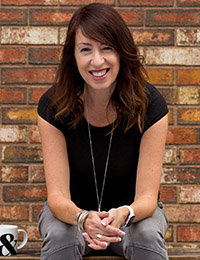 The BIG social media mistake you’re almost definitely making
The BIG social media mistake you’re almost definitely making
By Sarah Townsend
November 19, 2020
As freelancers and small biz owners, we have a love–hate relationship with social media. On the one hand, it’s a vital source of connection, information, and even business. On the other hand, it’s a huge distraction that drains our time – and our attention – when we should be focused on achieving those deadlines.
But there’s one
giant social media mistake you’re almost definitely making. What’s the secret to making social media work for you, without losing your day – and your mind?!
We all rely on our online communities – now more than ever! Regular engagement on LinkedIn, Facebook groups and Twitter hours provide everything from collaboration and advice to “your-client-did-WHAT?!” support.
They’re life support for freelancers.
But, social media comes with a warning.
If you’re not disciplined – in fact, even if you
are – social media can be a dangerous distraction.
It’s also an enormous source of pressure. It sits on your devices like a digital conscience, taunting you with all the things you
should have done:
•
“Everyone’s talking about LinkedIn stories yet you haven’t even posted! You’re getting left behind.”
•
“You know there’s no point even having a Facebook page these days unless you’re prepared to dig deep and advertise!”
•
“Why haven’t you shared a witty post on Twitter this morning? What’s wrong with you?”
•
“You haven’t posted on Instagram for days… surely you have something to share?!”
Social media wants a piece of you. And it wants it
now.
But listen up!
Unless you have literally no work – and if that’s the case, I humbly suggest you have bigger problems than how to manage your social media presence –
stop trying to do it all!
The secret to social media success is to pick no more than two platforms and do them
really well.
There’s nothing wrong with being present on every platform – establishing a presence across all sites certainly won’t harm your Google ranking. But as long as your information is up-to-date and relevant, and you check in regularly to respond to any messages, it’s okay to leave it at that.
You don’t have to master stories and reels on Instagram. You don’t have to post thought-provoking posts that get thousands of impressions on LinkedIn. And you don’t have to become a master at Facebook ads (there are plenty of specialists out there who can help you if you need it).
Once you’ve accepted this approach, how do you know which platforms to choose?
Good question.
You know where you feel at home. If Instagram makes you feel old, or you find LinkedIn just plain boring, it’s best to give them a wide berth.
The best approach is to hang out where your clients are. As B2B freelancers and business owners, LinkedIn and Twitter are likely to be your best fit, while B2C business with products to showcase are more likely to find their audience on Facebook, Instagram or Pinterest.
Run your social media – don’t let it run you
Once you’ve picked your platforms of choice, here are a few tips to help you get the best out of your social media marketing.
LinkedIn
Whatever business you’re in, you should have a personal profile on LinkedIn. Think of it as a virtual CV that showcases your skills and experience. You don’t have to spend time engaging, liking and posting, but at least be present.
If you want to do LinkedIn really well, start by optimising your profile. (There are plenty of people out there who’ll happily tell you how to do this – or get inspiration from other people. You’re welcome to use my profile as an example.)
Once you’re set up and ready to roll, check in at least once a day:
•
Like and comment on relevant posts.
•
Ask your clients for recommendations (I have over 100).
•
Congratulate people on their new jobs.
•
Create your own thought-provoking or entertaining posts.
•
Share long-form articles.
…and remember to update your profile regularly.
Twitter
Twitter gets a bad rap, most often from people who use it to advertise, then slate it for being a waste of time. No surprise there, then! If they dialled down the desperate, and focused instead on engaging, informing, and entertaining they’d have a very different Twitter experience.
The trick with Twitter is to give more than you take.
Join in Twitter hours. Share tips, tricks and advice. Show your personality. Build relationships. Reply to questions. Be authentically you. If you follow and engage with the right people (and it’s easy to create curated lists to manage the tweets you really want to see) Twitter can be a great source of inspiration and support.
Facebook
I remain unconvinced about Facebook pages as a tool for service businesses, but many B2C businesses find Facebook really effective – particularly if they’re prepared to spend time and money mastering Facebook ads.
If you choose to do Facebook really well, keep your page up to date, and aim to post daily. Funnies and thought-provoking questions traditionally get good engagement, as do behind-the-scenes posts and sharing stories about products in use. In reality, we all know it’s getting harder to achieve a good reach and engagement on Facebook without paying to advertise – but that’s a whole other post.
Instagram and Pinterest
Great social media content doesn’t require expensive gear. B2B businesses that choose to focus on the more visual platforms can get busy with their smartphone camera and a whole host of tools and start creating engaging posts that reflect their brand.
Free editing tools such as
Snapseed and
Afterlight give photos the edge, while apps such as
Canva and
Spark Post make it easy to create eye-catching posts.
If you decide to focus on Instagram or Pinterest, take the time to optimise your bio and experiment to find the hashtags and post types that get the best engagement from your audience. Don’t be afraid to take inspiration from businesses that do these platforms well – just no outright copying (remember, your brand look and tone of voice should be unique to you).
If you combine this advice with the discipline to check in on social just a couple of times a day, you’ll soon notice the difference it makes to your productivity and wellbeing. Let me know how you get on!
Want to read more?
The advice in this post has been adapted from Survival Skills for Freelancers – my #1 bestselling guide to navigating the ups and downs of self-employment without burnout. For more freelance tips and advice, sign up for my monthly
Clever Copy Club newsletter, follow me on
Twitter or connect on
LinkedIn.
 Sarah Townsend is a freelance marketing copywriter and the author of Survival Skills for Freelancers – the essential guide to self-employment. The #1 bestseller has been described as “absolute gold”, “a pocket business coach”, “warm wisdom” and “an instant gem” and is available exclusively on Amazon in paperback and Kindle formats.
Sarah Townsend is a freelance marketing copywriter and the author of Survival Skills for Freelancers – the essential guide to self-employment. The #1 bestseller has been described as “absolute gold”, “a pocket business coach”, “warm wisdom” and “an instant gem” and is available exclusively on Amazon in paperback and Kindle formats.